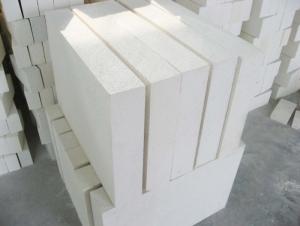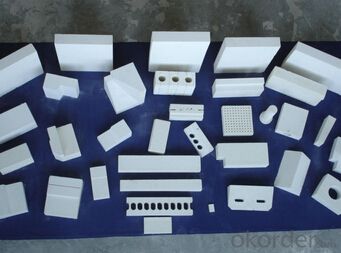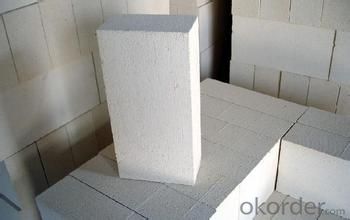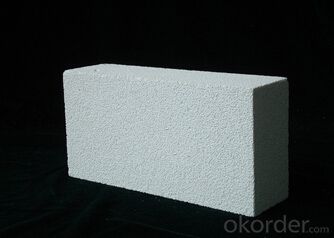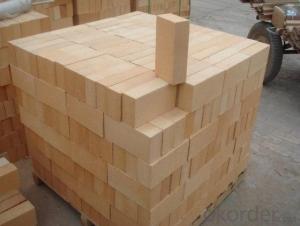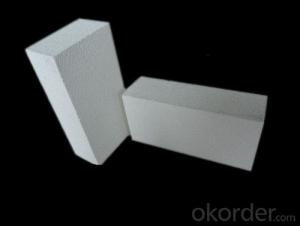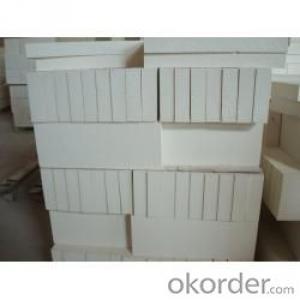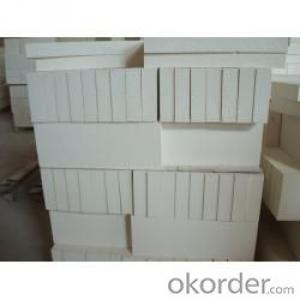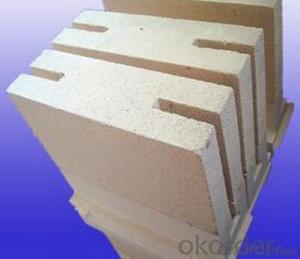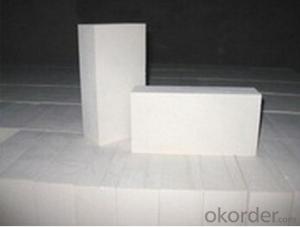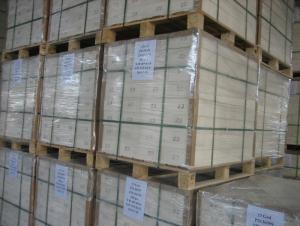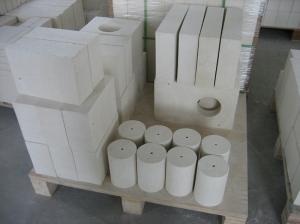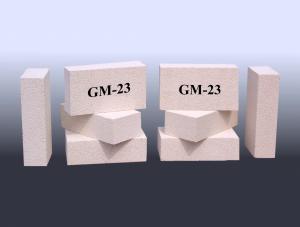Insulating Fire Brick - Refractory Mullite Insulating Refractory Brick JM 30
- Loading Port:
- Shanghai
- Payment Terms:
- TT OR LC
- Min Order Qty:
- 20 m.t.
- Supply Capability:
- 20 m.t./month
OKorder Service Pledge
OKorder Financial Service
You Might Also Like
General Information
CMAX insulating firebricks are classified under temperature between 1300℃ to 1700℃, manufactured from high purity alumina clay.
1. Lower content of iron, alkaline and impurities, good high temperature properties.
2. Homogeneous structure, light weight, energy saving because lower heat storage in the furnace during cooling cycles.
3. High strength, good thermal shock resistance under high temperature.
4. Precise sizes due to grinding and shaping after sintering, which meets the requirement of construction.
5. Max service temp: Up to 1730C (3160F)
Feature
Light weight and low thermal conductivity
Low heat storage
Low iron and impurities
High thermal shock resistance
Application of Insulating brick
Metallurgical Industry: blast furnace, hot blast furnace, heating furnace, etc..
Petrochemical Industry: ethylene cracking furnace, hydrogen furnace, the main furnace, heating furnace, etc..
Ceramic industry: roller kiln, kiln, etc..
Glass industry: glass furnace regenerator, etc.
Carbon industry: carbon furnace, etc..
Aluminum electrolysis industry: aluminum reduction cell, etc.
Other industries: tunnel kiln, shuttle kiln, etc.
Advantages of heat insulation brick
Low thermal conductivity: many air holes will bring good thermal insulation effect, energy saving.
High crushing strength: high crushing strength, volume stability.
Low heat storage: small heat storage, absorb more heat, energy-saving effect is obvious.
Technical Data
ITEM | GJM30 | GJM28 | GJM26 | GJM23 |
Classification Temperature, ℉/℃ | 3000/1650 | 2800/1540 | 2600/1430 | 2300/1260 |
Bulk Density,g/cm³ | ≤1.0 | ≤0.9 | ≤0.8 | ≥0.5 |
Reheating Linear Change, % | ≤0.9 (1550℃,12 h) | ≤0.8 (1510℃,12 h) | ≤0.7 (1410℃,12 h) | ≤0.5 (1230℃,12 h) |
Al2O3 Content, % | ≥75 | ≥65 | ≥55 | ≥45 |
Fe2O3 Content, % | ≤0.5 | ≤0.6 | ≤0.7 | ≤1.0 |
Thermal Conductivity: | ||||
800℃, w/m.k | ≤0.39 | ≤0.37 | ≤0.35 | ≤0.18 |
1000℃, w/m.k | ≤0.43 | ≤0.41 | ≤0.39 | ≤0.20 |
1200℃, w/m.k | ≤0.48 | ≤0.46 | ≤0.43 | --- |
Insulating brick
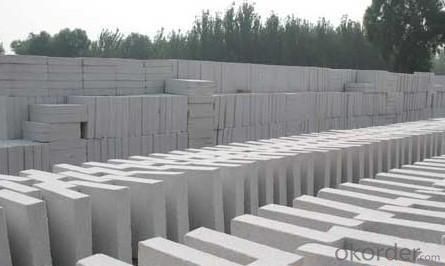

Common problem solution
1. What products do you have?
We have all kinds of refractory bricks, refractory casting materials, mortar, cement, ceramic fiber products, etc..
Or you can browse our products to choose what you need.
2. How to control product quality?
With strict quality control system throughout the material selection and production process, we have the quality of refractory materials and ceramic fiber products to meet customer requirements.
From the selection of raw materials, the quality of our control to start. The quality of the raw materials required for each batch of products in the use of the front line test. In the production process, through the quality control of workers, and then to each piece of classification, and through quality supervision and inspection.
3. Could you give me a brief introduction to the application of your product?
My Company is mainly engaged in steel, cement, glass, ceramics, petrochemical, electric power and other industries.
4. If I need you, what kind of information do you need?
In order to select the right products, we will provide us with information, such as the United States, technical data, order quantity, product applications, etc..
If you have any questions, please contact us.
- Q: Do insulating fire bricks require maintenance?
- Maintenance is required for insulating fire bricks. Despite their reputation for durability and ability to withstand high temperatures, it is important to regularly maintain them to ensure they perform at their best and last a long time. One crucial aspect of maintenance is periodic cleaning. Over time, insulating fire bricks can collect dust, soot, and other debris, which can impact their insulation properties. It is therefore advisable to clean the bricks regularly to eliminate any build-up. This can be achieved by using a soft brush or a mild cleaning solution. Another vital aspect of maintenance involves checking for any cracks or damages. It is essential to inspect the bricks for signs of wear and tear to identify and address any issues before they worsen. Cracks or damages can compromise the insulation and stability of the bricks, so they should be repaired or replaced as necessary. Additionally, it is important to monitor the condition of the mortar or refractory cement used to hold the insulating fire bricks together. Over time, the mortar can deteriorate due to exposure to heat and other elements. Regularly inspecting and repairing any damaged mortar helps to maintain the structural integrity of the fire bricks. Furthermore, it is crucial to adhere to the manufacturer's instructions and recommendations for the specific type of insulating fire bricks being used. This may involve following guidelines for installation, temperature limits, and any other specific care instructions. In conclusion, while insulating fire bricks are sturdy, regular maintenance is required to ensure they perform optimally and have a long lifespan. Proper cleaning, inspecting for damage, and following the manufacturer's guidelines are essential components of maintaining insulating fire bricks.
- Q: How do insulating fire bricks perform in terms of sound insulation?
- Insulating fire bricks are effective in terms of sound insulation due to their dense and porous structure, which helps to absorb and dampen sound waves.
- Q: Can insulating fire bricks be used in the construction of radiant tubes?
- Yes, insulating fire bricks can be used in the construction of radiant tubes. These bricks are designed to have low thermal conductivity, which makes them an excellent choice for insulating applications such as radiant tubes. They can help to minimize heat loss and improve the efficiency of the radiant heating system.
- Q: Can insulating fire bricks be used in the construction of crucibles?
- Yes, insulating fire bricks can be used in the construction of crucibles. These bricks are designed to withstand high temperatures and provide excellent insulation, making them suitable for use in crucibles where extreme heat is required.
- Q: Are insulating fire bricks resistant to thermal bridging?
- Insulating fire bricks possess resistance against thermal bridging. Thermal bridging arises when a material allows heat to flow directly, thereby bypassing the insulation. Insulating fire bricks counteract this issue by minimizing thermal conductivity, which renders them ineffective at conducting heat. This characteristic aids in maintaining a uniform temperature on either side of the brick, thereby preventing thermal bridging and enhancing the overall insulation performance.
- Q: Are insulating fire bricks suitable for insulation in power boilers?
- Insulating fire bricks can be suitable for insulation in power boilers depending on the specific requirements and conditions of the boiler. Insulating fire bricks are known for their high temperature resistance and low thermal conductivity, which makes them effective in reducing heat loss and improving energy efficiency in various applications. However, when considering their use in power boilers, several factors need to be taken into account. Firstly, the operating temperature and pressure of the boiler should be considered to ensure that the insulating fire bricks can withstand these conditions without any degradation or failure. Power boilers typically operate at high temperatures and pressures, so it is important to choose insulating fire bricks that have a high temperature rating and can withstand the required pressure. Additionally, the composition and structure of the insulating fire bricks should be considered. Some power boilers may contain corrosive or abrasive substances, which can potentially damage the insulating fire bricks over time. Therefore, it is important to select insulating fire bricks that are resistant to corrosion and abrasion, or to consider additional protective measures such as coatings or linings. Furthermore, the thermal conductivity of the insulating fire bricks should be evaluated. While insulating fire bricks have low thermal conductivity compared to other refractory materials, it is important to ensure that they provide sufficient insulation for the specific requirements of the power boiler. This may involve calculating heat transfer rates and determining the appropriate thickness and density of the insulating fire bricks to achieve the desired insulation performance. Ultimately, the suitability of insulating fire bricks for insulation in power boilers depends on careful consideration of factors such as temperature, pressure, composition, structure, and thermal conductivity. Engaging with experts and conducting proper evaluations and calculations will help determine if insulating fire bricks are a suitable choice for insulation in a particular power boiler application.
- Q: Are insulating fire bricks resistant to reducing atmospheres?
- Yes, insulating fire bricks are resistant to reducing atmospheres.
- Q: Can insulating fire bricks be used in high-temperature insulation blankets for aerospace applications?
- Yes, insulating fire bricks can be used in high-temperature insulation blankets for aerospace applications. Insulating fire bricks are known for their ability to withstand high temperatures and provide excellent insulation properties. By incorporating them into insulation blankets, they can effectively protect against heat transfer and maintain thermal stability in aerospace applications.
- Q: Can insulating fire bricks be used in kiln car construction?
- Yes, insulating fire bricks can be used in kiln car construction. Insulating fire bricks are made from lightweight materials that have excellent insulating properties, such as ceramic fibers or lightweight refractory aggregates. These bricks have low thermal conductivity, which means they can effectively retain heat and prevent heat transfer to the outer surface of the kiln car. Using insulating fire bricks in kiln car construction offers several benefits. Firstly, it helps to reduce heat loss, which improves energy efficiency and lowers fuel consumption. This is particularly important in high-temperature applications like kilns, where maintaining a consistent temperature is crucial. Secondly, insulating fire bricks can help to protect the kiln car from thermal stresses and cracking. Kilns undergo significant temperature changes during firing cycles, and the use of insulating fire bricks can help to minimize thermal shock and extend the lifespan of the kiln car. Furthermore, insulating fire bricks are lightweight compared to traditional refractory bricks, making them easier to handle and install in kiln car construction. This can lead to cost savings in terms of labor and transportation. However, it's important to note that insulating fire bricks have lower strength and durability compared to dense refractory bricks. Therefore, they are typically used in the hot face lining of kilns, while a more robust material is used for the kiln car structure. In conclusion, insulating fire bricks can be effectively used in kiln car construction to improve energy efficiency, protect against thermal stresses, and enhance the overall performance of the kiln.
- Q: What is the average density of insulating fire bricks?
- The average density of insulating fire bricks typically ranges from 0.6 to 1.2 grams per cubic centimeter.
Send your message to us
Insulating Fire Brick - Refractory Mullite Insulating Refractory Brick JM 30
- Loading Port:
- Shanghai
- Payment Terms:
- TT OR LC
- Min Order Qty:
- 20 m.t.
- Supply Capability:
- 20 m.t./month
OKorder Service Pledge
OKorder Financial Service
Similar products
Hot products
Hot Searches
Related keywords
